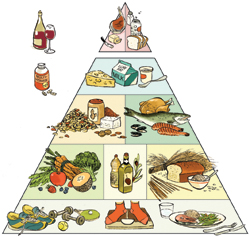A great many factors influence how much humans eat—and overeat. Social, environmental, psychological, economic, and biological factors can all trigger our appetites to behave badly. Among those pressures, flavor ranks as the most important: we tend to eat more of that which tastes good to us.
In our struggle with our weight, we often find that willpower alone is not enough to overcome the addictiveness of the foods that surround—and tempt—us day in and day out. We may be able to put up with the tedium of a low fat, low carb diet for a day or two, or for several weeks even; over time, however, our willpower weakens, and we backslide into unhealthy eating habits again. We need a more powerful weapon that can sustain us in our fight against weight gain. Flavor is such a weapon.
We all know that foods high in volume, such as vegetables, fruits, soups and stews, fill one up with fewer calories. These wholesome foods are also generally rich in nutrients. Making them a regular part of a healthful diet, on the other hand, can be difficult because most people don’t like the taste of vegetables.
Is there a way to flavor up the veggies to make them more palatable? The answer is yes.
In my experience, we can arrive at a happy compromise between flavor and wholesomeness by mixing veggies with meats or stir-frying veggies in small amounts of oil.
Have you noticed that sweet foods taste even sweeter when they are made with oil? This is because fat can serve as a vehicle for flavors. Even though it may not add a specific flavor to food, it enhances the potency of other added flavors. In the case of sugared foods, the oil distributes the sweetness throughout the mouth. Similarly, when we add oil to veggies, it can bring out all the hidden flavors in them and make them more delicious.
We have two picky eaters at our house. Both abhor veggies and wouldn’t touch veggies regardless of my best efforts to persuade them to. One day, I tried a recipe I got from a friend of mine. When stewing pork spare ribs, I put in some carrot and turnip cubes. The dish turned out to be a big success. Both of my children asked for seconds—something that never happened before.
Another favorite dish of ours is sesame tofu. Tofu, as we all know, is rich in protein and calcium. A lot of people are aware of its nutritional value but shy away from it because of its drab and slightly bitter taste. The next time you eat tofu, try adding one drop of sesame oil and some soy sauce to taste. You will find that the whole thing tastes different.
Tag: cook
How to Cook for the Ideal Body Weight
Nowadays, even a kindergartener can tell you that healthy eating comes in the form of a pyramid.
source: http://www.hsph.harvard.edu/nutritionsource/what-should-you-eat/pyramid/
According to the Healthy Eating Pyramid, you should eat a variety of foods. A balanced diet is one that includes all the food groups. More importantly, the Pyramid shows that not all foods are created equal. You should eat more foods from the bottom part of the pyramid (vegetables, whole grains) than the top (red meat, refined grains).
In general, home-cooked meals are preferred over processed foods because with the former, you have more control over what’s put into your mouth. For many people trying to eat a healthy diet, this presents special challenges. How can you eat home-cooked meals when you don’t particularly enjoy cooking yourself? What options do you have rather than to hire someone to do the cooking for you?
I am not much of a cook myself. But over the years, I have found ways to make the cooking experience more pleasant. Cooking home-made meals doesn’t have to involve long hours of slaving away in the kitchen, as I found out.
First, you need to make sure you’re properly equipped. Three cooking utensils are indispensable to a kitchen and worth every penny you spend on them: a deep stainless pot that is sturdy enough for daily stir-frying, a slow cooker, and a pressure cooker.
Vegetables are probably the only food group in the pyramid that you can take in as much as you want. Many people know that vegetables are good for them, but they shy away from vegetables simply because they don’t like the taste. Nutritionists will tell you that the most healthy way to prepare veggies is to steam them, but those seldom taste very good. Is there a way to make veggies more appetizing and still relatively healthy to eat? The answer is yes. You can, for instance, stir-fry them with canola oil. At our house, we serve 2 kinds of stir-fried veggies at every meal.
By the way, eating veggies in the form of a salad isn’t necessarily the best practice for weight control, contrary to popular belief. Unless you prepare the salad dressing yourself, you have no control over what goes into your mouth.
A slow cooker is a big help to people running hectic lives. It is convenient in that you can just throw in the ingredients, set the timer, and walk way. You don’t need to watch it cook—it will cook on its own. Using a slow cooker, you can stew veggies with meats. When cooked this way, veggies will take on the flavor of the meats and appeal to the pickiest eater around.
A pressure cooker can also come in handy when you are into healthy eating and cooking. Foods such as beans and brown rice are excellent food choices, but the sheer amount of time it takes to cook them can turn people away. Do not worry. If you pre-soak them in advance, and cook them with a pressure cooker, you can whip up a meal in no time at all.

